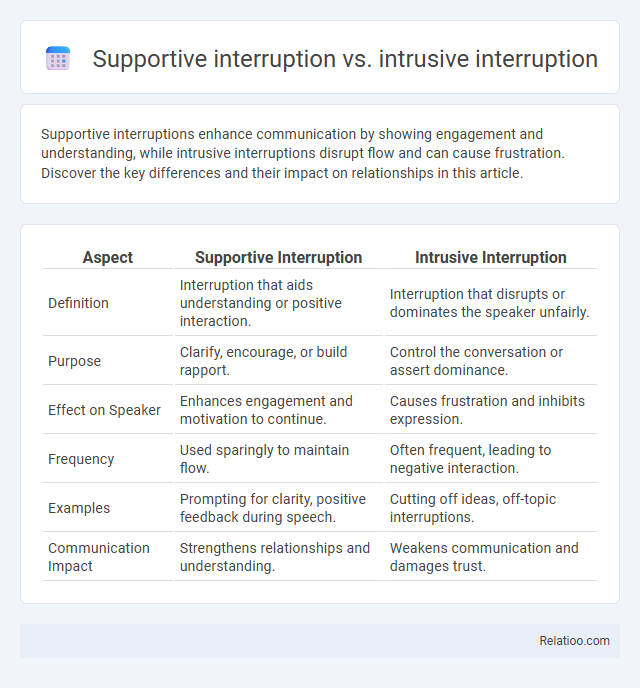Supportive interruptions enhance communication by showing engagement and understanding, while intrusive interruptions disrupt flow and can cause frustration. Discover the key differences and their impact on relationships in this article.
Table of Comparison
| Aspect | Supportive Interruption | Intrusive Interruption |
|---|---|---|
| Definition | Interruption that aids understanding or positive interaction. | Interruption that disrupts or dominates the speaker unfairly. |
| Purpose | Clarify, encourage, or build rapport. | Control the conversation or assert dominance. |
| Effect on Speaker | Enhances engagement and motivation to continue. | Causes frustration and inhibits expression. |
| Frequency | Used sparingly to maintain flow. | Often frequent, leading to negative interaction. |
| Examples | Prompting for clarity, positive feedback during speech. | Cutting off ideas, off-topic interruptions. |
| Communication Impact | Strengthens relationships and understanding. | Weakens communication and damages trust. |
Understanding Supportive vs Intrusive Interruption
Supportive interruption occurs when Your interjection enhances the conversation by providing encouragement, clarification, or positive reinforcement, fostering mutual understanding. Intrusive interruption disrupts the speaker's flow by cutting off ideas or shifting focus, often leading to frustration and breakdowns in communication. Distinguishing between these types of interruptions is crucial for effective dialogue and maintaining respectful interactions.
Defining Supportive Interruption
Supportive interruption refers to a conversational technique where one speaker interjects to encourage, clarify, or add positively to another's dialogue without causing disruption. Unlike intrusive interruption, which disrupts or overrides the speaker's message, supportive interruption aims to enhance understanding and maintain flow. Your communication effectiveness improves by recognizing when to use supportive interruptions to foster collaboration and engagement.
Characteristics of Intrusive Interruption
Intrusive interruptions are characterized by their disruptive and unwelcome nature, often breaking the flow of conversation abruptly and causing loss of focus. Unlike supportive interruptions, which aim to clarify or encourage, intrusive interruptions typically disregard the speaker's intent, leading to frustration or misunderstanding. Your awareness of these characteristics helps in managing communication more effectively by minimizing negative interruptions.
Psychological Impact of Supportive Interruption
Supportive interruption, characterized by empathetic and non-disruptive engagement, fosters trust and enhances communication effectiveness, reducing stress and promoting emotional safety. In contrast, intrusive interruption often triggers frustration and anxiety, disrupting cognitive processing and undermining interpersonal rapport. Overall, supportive interruption contributes positively to psychological well-being by validating speaker emotions and encouraging open dialogue.
Negative Effects of Intrusive Interruption
Intrusive interruption disrupts the flow of conversation more significantly than supportive interruption by abruptly cutting off the speaker, often leading to misunderstandings and increased frustration. While supportive interruptions aim to encourage or clarify without derailing dialogue, intrusive interruptions contribute to communication breakdown and reduced speaker confidence. Research shows that intrusive interruptions are strongly linked to negative emotional responses and decreased conversational satisfaction.
Communication Strategies for Supportive Interruption
Supportive interruption in communication involves respectful and constructive interjections that enhance clarity and understanding without disrupting the speaker's flow. Unlike intrusive interruption, which can hinder effective dialogue by causing frustration or miscommunication, supportive interruption aims to assist Your conversational partner by providing timely feedback or encouragement. Employing communication strategies such as active listening, empathetic responses, and clarifying questions ensures that supportive interruptions promote engagement and mutual comprehension.
Recognizing Contexts for Appropriate Interruption
Supportive interruption involves interjecting to enhance understanding or provide helpful feedback, typically in collaborative or educational settings, whereas intrusive interruption disrupts the flow of conversation and may hinder communication by imposing irrelevant or dominant remarks. Recognizing contexts for appropriate interruption requires sensitivity to social cues, conversational norms, and the relationship between speakers, ensuring your interjections contribute constructively without derailing the dialogue. Your ability to gauge timing, purpose, and receptiveness is critical to differentiating helpful interjections from those that may be perceived as rude or intrusive.
Minimizing Intrusiveness in Conversations
Supportive interruption enhances conversational flow by clarifying or adding relevant information without derailing the speaker's intent, whereas intrusive interruption disrupts communication by prematurely cutting off or dominating the dialogue, negatively impacting rapport. Minimizing intrusiveness involves strategies such as active listening, timing interruptions carefully, and using non-verbal cues to signal intent, which fosters respectful interaction and preserves speaker autonomy. Effective conversation management prioritizes understanding speaker cues to balance participation without compromising message coherence or emotional connection.
Balancing Engagement and Respect in Dialogue
Supportive interruptions enhance dialogue by showing active listening and encouraging deeper engagement without overriding the speaker's message, while intrusive interruptions disrupt flow and can diminish respect, often perceived as dominating the conversation. Effective communication requires recognizing when your interjection supports the exchange versus when it intrudes, allowing you to balance engagement with respect in every interaction. Mastering this distinction helps maintain rapport, foster understanding, and ensure your contributions positively influence the dialogue.
Key Takeaways: Fostering Positive Conversational Interruption
Supportive interruptions demonstrate active engagement by affirming or building on Your speaker's ideas, while intrusive interruptions disrupt the flow and can hinder communication. Understanding the distinction between these types allows for fostering positive conversational interruption, promoting clarity and collaboration. Encouraging supportive interruptions enhances mutual understanding and strengthens interpersonal connections during dialogue.

Infographic: Supportive interruption vs Intrusive interruption
 relatioo.com
relatioo.com